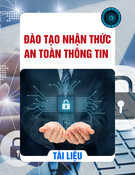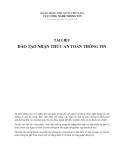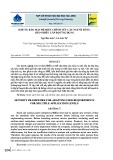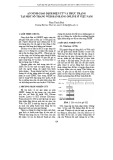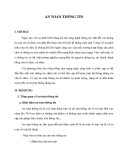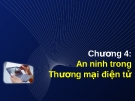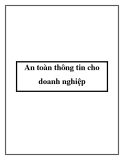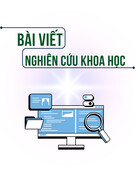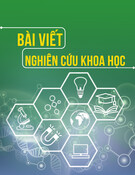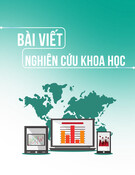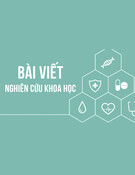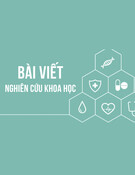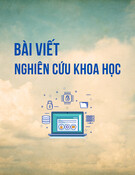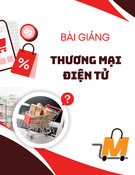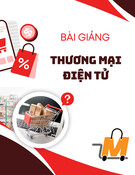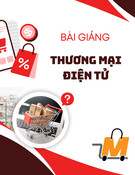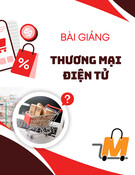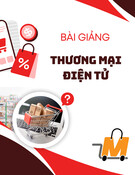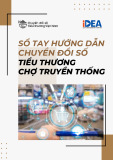
2013
Edelman Trust Barometer
Executive Summary

1
Less than one fifth of the general public believes
business leaders and government officials will tell
the truth when confronted with a difficult issue.
There also is a growing trust gap between institu-
tions and their leaders – globally, trust in business
is 32 points higher than trust in business leaders
to tell the truth; trust in government is 28 points
higher than it is for government officials.
The continuing lack of faith in traditional leaders was reinforced by
a series of highly publicized wrongdoings again last year. Former
McKinsey managing partner Rajat Gupta was convicted of pass-
ing inside information. Bob Diamond resigned as CEO of Barclays
after the revelation of rampant fixing of the Libor rate by traders.
Bo Xilai was removed from the highest ranks of the Chinese gov-
ernment after exposure of personal corruption.
The research confirms the democratizing trend of recent years –
the redistribution of influence from traditional authority figures such
as CEOs and prime ministers toward employees, peers and people
with credentials, including academics and technical experts. A
professor or person like yourself is now trusted nearly twice as
much as a chief executive or government official. The hierarchies
of old are being replaced by more trusted peer-to-peer, horizontal
networks of trust.
The shock of 2008, the subsequent recession and misdeeds by
establishment figures have forced a reset in expectations of insti-
tutions and their leaders. What a company does as well as how it
does it are now both dependent upon trust and credibility. Running
a profitable business and having top-rated leadership no longer,
alone, build long-term trust. In fact, these operational-based at-
tributes have become an expectation. Today, business builds trust
by treating employees well, exhibiting ethical
and transparent practices and placing cus-
tomers ahead of profits while also delivering
quality products and services. Business must
embrace a new mantra: move beyond earn-
ing the License to Operate – the minimum
required standard – toward earning a License
to Lead – in which business serves the needs
of shareholders and broader stakeholders by
being profitable and acting as a positive force
in society.
Business must also change the way it engag-
es stakeholders. We are in an era of skepti-
cism; people need to see or hear something
three to five times in different places before
believing it, and learn equally from traditional
and social channels. The traditional pyramid
of authority, with elites driving communica-
tions top down to mass audiences, is now
joined by an inverted pyramid of community
– employees, action consumers and social
activists involved in real-time, horizontal, con-
stant peer-to-peer dialogue resulting in a new
diamond of influence. Smart institutions will
use vertical one-way communications while
continually participating in the ongoing hori-
zontal conversation.
Times call for Inclusive Management in
which CEOs and government officials:
Establish a vision and transparently share
reasoning, purpose and results.
Enlist a broader range of advocates, includ-
ing employees, action consumers, social ac-
tivists, academics and think tanks, seeking
their input and reaction.
Embrace all channels of communications,
actively listening to new voices of influence,
and adapting.
Shift from vision to implementation with
transparent measures guided by continual
engagement.
Crisis in Leadership
Government Leaders
Business Leaders
26% 20% 19% 18%
SOLVE SOCIAL OR
SOCIETAL ISSUES
CORRECT ISSUES WITHIN
INDUSTRIES THAT ARE
EXPERIENCING PROBLEMS
MAKE ETHICAL AND
MORAL DECISIONS
TELL YOU THE TRUTH,
REGARDLESS OF HOW COMPLEX
OR UNPOPULAR IT IS
15% 15% 14% 13%
SOLVE SOCIAL OR
SOCIETAL ISSUES
CORRECT ISSUES WITHIN
INDUSTRIES THAT ARE
EXPERIENCING PROBLEMS
MAKE ETHICAL AND
MORAL DECISIONS
TELL YOU THE TRUTH,
REGARDLESS OF HOW COMPLEX
OR UNPOPULAR IT IS
The 2013 Edelman Trust Barometer demonstrates a serious crisis of confidence in leaders of both
business and government.
Crisis in Leadership – Trust in Ethics and Morality Very Low
How much do you trust business and government leaders to
do the following?

22013 | Trust Barometer
The times also demand that leaders behave differently. As Jeffrey
Sonnenfeld, professor and dean at Yale University, notes: “Reli-
ant, but sidetracked leaders have learned, they cannot rely on their
prominent roles or ideas alone to win over key constituents. Ground-
ed Leadership builds legitimacy in key constituent groups and is
based in personal dynamism, empathy, authenticity, inspirational
goals and courage.”
The fi nancial services industry has a tremendous opportunity to be
the litmus test for this new approach. With its issues of money-
laundering, bid-rigging and trading-desk-malfeasance and once
again being the least-trusted business sector, industry leaders
must explain their business model, have understandable and
transparent metrics, engage in all channels of communications
and prove the industry is working in the public interest. As Profes-
sor John Coffee of Columbia University said in a recent editorial in
the Financial Times: “Global banks will need to compete not only
over price and quality of services but over reputation.”
Tomorrow’s trusted leaders will authentically embrace Inclusive
Management. As Ford CEO Alan Mulally has said: “You learn
from everybody.”
ACTION CONSUMERS
GENERAL POPULATION
BOARD OF DIRECTORS
ACADEMICS
TECHNICAL EXPERTS
ELITE MEDIA
EMPLOYEES
TO 2013FROM 2000
PYRAMID OF
COMMUNITY
(Horizontal)
PYRAMID OF
AUTHORITY
(Vertical)
Few
Dictate
Fixed
Monologue
Control
Many
Co-Create
Flexible
Dialogue
Empowerment
SOCIAL
ACTIVISTS
Table of Contents
State of Trust
page 3
Trust in
Institutions
page 4
Determining
Factors for Trust
in Business
page 6
Trust in Banking &
Financial Services
Industry
page 7
Most Trusted
Spokespeople
page 8
Building Trust
page 9
New Infl uence
Dynamic
page 10
The New Dynamic: The Diamond of Infl uence

3
Trust Is on the Rise, But Storm Clouds Loom
Building trust has never been more important – nor more challenging
Trust in business, government, media and NGOs is on
the rise.
This year, the Trust Index rose from a score of 51 in 2012
to 57 (fi gure 1). The number of countries that the survey
showed to be “trusters” – those with at least a 60 percent
average trust in the four institutions – rose from 2012, in
which there were eight, to 2013, in which there are nine.
But the intensity of trust in each institution remains low,
despite a slight uptick this year, with “trust a great deal”
in NGOs the highest at a still-modest 22 percent. “Trust
a great deal” is even lower in government (16 percent)
and business and media (tied at 17 percent).
Where we might have distinguished trust by geography
in the past, today that no longer holds. For instance,
while much of Asia falls in the truster category (six of
the nine trusters) it’s not across the board, with Japan
and South Korea, as with much of the developed world
surveyed, categorized as distrusters. Of the 17 coun-
tries considered neutral or distrusters, 12 of them (71
percent) are developed countries, while only fi ve are
emerging countries. But even this distinction does not
neatly explain trust levels.
Figure 1: Edelman’s Trust Index: After a Year of High Distrust in 2012, Shift Back to Neutral in 2013
Composite score is an average of a country’s trust in all four institutions.
2011
GLOBAL 55 GLOBAL 51 GLOBAL 57
Big Changes
from 2008
Germany +19
China +18
Canada +14
India +11
Big Changes
from 2012
Germany +16
France +14
UK +12
US +10
Big Changes
from 2012
Germany +16
France +14
UK +12
US +10
2012 2013
Brazil 80
UAE 78
Indonesia 74
China 73
Netherlands 73
Mexico 69
Singapore 67
Argentina 62
India 56
Italy 56
Canada 55
South Korea 53
Sweden 52
Japan 51
Australia 51
Spain 51
France 50
Poland 49
Germany 44
U.S. 42
U.K. 40
Russia 40
Ireland 39
China 76
UAE 68
Singapore 67
India 65
Indonesia 63
Mexico 63
Netherlands 61
Hong Kong 61
Canada 58
Malaysia 57
Italy 56
Argentina 54
Australia 53
Brazil 51
Sweden 49
U.S. 49
South Korea 44
Poland 44
U.K. 41
Ireland 41
France 40
Germany 39
Spain 37
Japan 34
Russia 32
China 80
Singapore 76
India 71
Mexico 68
Hong Kong 67
UAE 66
Malaysia 64
Canada 62
Indonesia 62
U.S. 59
Netherlands 59
Brazil 55
Germany 55
France 54
Sweden 54
UK 53
Italy 51
Australia 50
Poland 48
S. Korea 47
Ireland 46
Argentina 45
Spain 42
Turkey 42
Japan 41
Russia 36
One of those five emerging countries is Brazil,
for example, which only two years ago, in 2011, was
the top global truster at 80. Today, trust Brazilians hold
for the four institutions has plunged to 55. Another of
the fi ve is Russia, which hasn’t shown much increase
in trust at all; it’s been at the bottom two years running,
32 in 2012 and 36 this year.
So while there is a correlation between economic
performance and trust, performance is not determina-
tive. Other factors come into play (see page 6 for more).
“Informed publics” vs. General Population
The Barometer shows a nine-point contrast in trust
between the general population (Trust Index score of 48)
and informed publics (Trust Index score of 57), which will
make it a challenge for business and government lead-
ers to build consensus and respond to serious issues of
the day. Broken down between developed and emerg-
ing countries, trust is signifi cantly higher among both
the general population and informed publics in emerg-
ing countries than in developed countries. In fact, no
developed countries were trusters based on the general
population and only two of nine were trusters based
on the informed publics.
Responses 6-9 only on 1-9 scale; 9 highest; Informed Publics ages 25-64

42013 | Trust Barometer
Trust in Institutions – NGOs, Media, Government and Business
Drilling down into trust in each of the four institu-
tions shows some intriguing disparities and one
statistical commonality: trust has risen from 2012
across all institutions by 5 points (fi gure 2).
NGOs. Trust in NGOs remains high, with an
overall 88 percent of countries surveyed over
50 percent (the highest is Mexico, an emerg-
ing market, at 83 percent; the lowest is Japan,
a developed market, at 37 percent). The most
notable change over time is in China, where
only fi ve years ago trust in NGOs was 48 per-
cent; today it is 81 percent. Three of the top fi ve
countries with the highest trust in NGOs, like
China, are emerging markets.
Media. Trust in media, at 57 percent globally,
continues to improve with a fi ve-point increase
from 2012. Sixty-two percent of countries sur-
veyed have a trust score of 50 percent or above,
compared to 50 percent of countries surveyed
in 2008. Trust is signifi cantly higher in emerging
countries than in developed countries (fi gure 3).
Large gaps in trust also exist in how the general
population view types of media, with emerg-
ing markets placing more trust in social by 32
points, traditional by 14 points, online search
engines by 24 points, hybrid by 24 points and
owned by 22 points.
Trust in media breaks down along generational
lines, as well. Among all ages in the general
population, trust in traditional media and online
search engines is highest. But trust in the other
three categories of media drops among older
generations particularly (age 45+) to an average
of 34.5 percent for hybrid, 34 percent for owned
and 33 percent for social. Among the young-
est generation (ages 18-29), trust is highest in
online search engines (61 percent) and lowest
in owned media (44 percent).
Government. While trust in government is up,
among informed publics it remains below 50
percent in 62 percent of countries surveyed,
with 56 percent of those in developed countries.
Fifty percent of the general public who re-
ported trusting government less over the past
year agree that “corruption and fraud” and
“wrong incentives driving policies” account
Figure
3: Mainstream Media Reigns in Developed Markets,
Equivalence Among Sources in Emerging Markets
How much would you trust each type of source for general news
and information?
Figure 2: Trust on the Rise Across Institutions, But Weak Intensity
Persists
How much do you trust each institution to do what is right?
TRUST A GREAT DEAL
NGOS
BUSINESS
MEDIA
GOVERNMENT
2012 2013 2012 2013
2012 2013 2012 2013
Trust Total: 43%
Trust Total: 48%
Trust Total: 53%
Trust Total: 58%
Trust Total: 52%
Trust Total: 57% Trust Total: 58%
Trust Total: 63%
How much you trust that institution to do what is right
12%
15%
16%
17%
14%
19%
17%
22%
58%
58%
43%
41%
40%
51%
47%
32%
26%
30%
65%
71%
56%
58%
52%
TRADITIONAL MEDIA
ONLINE SEARCH
ENGINES
HYBRID MEDIA
SOCIAL MEDIA
OWNED MEDIA
Global
Developed
Emerging
How much would you trust each type of source for general news and information?
59%
61%
49%
47%
44%
61%
60%
48%
45%
43%
56%
56%
40%
37%
37%
54%
49%
29%
29%
31%
TRADITIONAL MEDIA
ONLINE SEARCH
ENGINES
HYBRID MEDIA
SOCIAL MEDIA
OWNED MEDIA
18-29
30-44
45-64
65+
GLOBAL AGE BREAKDOWN
Responses 6-9 and 8-9 on 1-9 scale; 9 highest; Informed Publics ages 25-64
Responses 6-9 only on 1-9 scale; 9 highest; General Population

